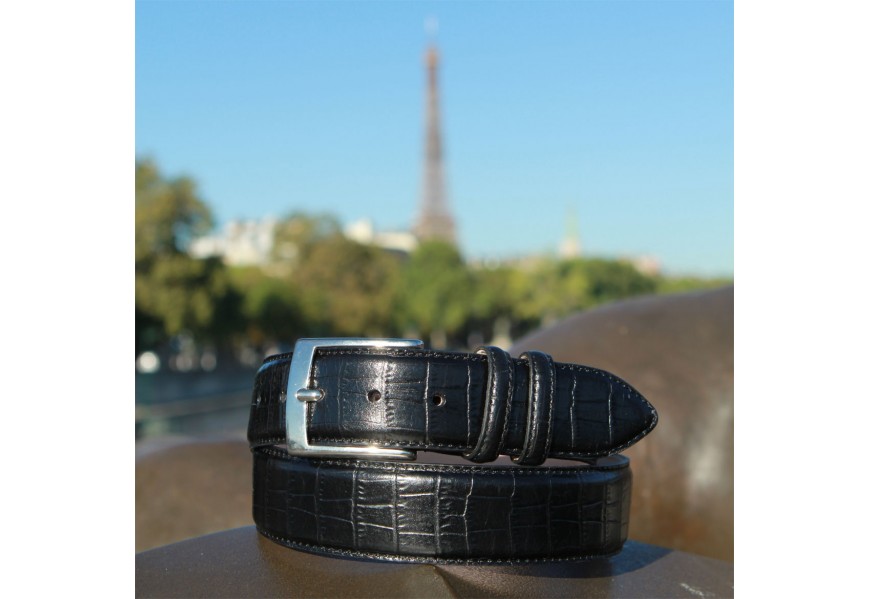
How to maintain your leather belt?
Leather is a living material that needs to be treated with care if you want to keep it for a long time.
Fell for a beautiful genuine leather belt? Great choice! To make sure it lasts, a bit of maintenance goes a long way. Nothing complicated, promise: a few simple daily actions are enough to preserve its original appearance and help it develop, over time, that famous natural patina that only quality leather can offer.
This short guide shares easy tips to care for your leather belt and keep it beautiful, supple, and long-lasting. Because well-cared-for leather is an accessory that sticks with you for years... in style.
General care for your leather belt
Just like leather shoes, we recommend maintaining your belts regularly.
Regular cleaning
- After each use, wipe your belt with a soft, dry cloth to remove dust, sweat, and moisture.
- For light stains, use a slightly damp cloth or a leather-specific cleansing milk.
- Never use excessive water, abrasive products, or household cleaners.
Makeup remover or baby lotion contains too much water and isn’t nourishing enough for leather care, so avoid using them, even as a last resort.
Moisturizing and conditioning
- Apply a nourishing cream suited to the leather color (or colorless) every 3 to 6 months.
- This prevents drying, cracking, and preserves the natural suppleness of the leather.
- Buff with a soft cloth after application to restore shine.
Proper storage
- As we do in our shop, and if possible, hang your belts by the buckle.
- Otherwise, store the belt flat or rolled, away from moisture, sunlight, and direct heat sources.
- Use a fabric pouch or box to limit dust exposure.
Rotation
- If you wear a belt daily, alternate with another one to avoid premature wear at the same spots (holes, buckle, etc.).
Care based on leather color
Here are the recommended products and precautions depending on the leather color:
Black
- Black cream or polish
- Avoid wax buildup: buff well to prevent whitish marks in folds or seams.
Dark Brown / Chocolate
- Dark brown or tone-on-tone cream
- Test the product on a small area: some creams may darken the leather over time.
Light Brown / Camel
- Colorless or slightly tinted cream
- Avoid prolonged sun exposure which can alter or yellow the shade.
Beige / Cream / White
- Colorless cream only
- Very sensitive to stains: always apply a protective waterproof spray before wearing.
Colors (burgundy, blue, etc.)
- Tone-on-tone pigmented cream
- Always test on a discreet area: colored creams may darken or slightly change the original tone.
Care based on leather type
Full-grain leather (smooth, natural)
- The finest quality leather, uncorrected.
- Clean with a soft cloth + nourishing cream (colorless or pigmented).
- Occasional polishing to revive the tone.
- Sensitive to grease and water stains, treat promptly.
Tip: a natural balm with beeswax can restore shine and suppleness.
Corrected-grain leather
- Polished or printed surface, less sensitive.
- Easy to clean, colorless cream is usually enough.
- Avoid overly greasy products that can oversaturate the surface.
Suede / Nubuck leather
- Soft, matte look achieved through sanding.
- Very sensitive to water, stains, and grease.
- Dry care only: crepe or brass brush, then waterproof spray.
- For stains, use a special nubuck/suede cleaner.
Warning: never apply traditional cream or polish.
Suede (reversed split leather)
- Very supple, velvety inner texture.
- Same care as nubuck, but even more regularly.
- Brush dry after each use, use a suede eraser for marks.
Tip: always waterproof before the first use.
Summary: the 5 golden rules
1. Clean regularly with a soft cloth
2. Nourish the leather with suitable cream
3. Store your belts hanging or flat
4. Alternate belts to avoid premature wear
5. Match care products to the leather color and type
Key takeaway
With a few simple yet regular actions, your leather belt will last for many years without losing its charm. If you're unsure about a product or method, it's best to test on a small hidden area or ask for advice.
Bonus:
Don't rub the strap against the buckle when fastening.
Here’s a video showing the right way to do it:
And here's a video showing what not to do:
